Introduction
The Q1 Vintage Metagame Report is designed to show you what’s been going on in Vintage tournaments during the first three months of 2011. What decks
are winning, what decks are new on the scene, which decks are in decline, and which ones are over- or under-performing in the elimination rounds?
If you’re new to the Vintage format, or trying to return to the tournament scene after a break, this metagame report serves as a useful tool for you to
learn about the format; it shows you which decks are popular and which decks are winning, and it includes cutting-edge decks and tech from all over the
world. Changes to this report include the addition of graphs to compare Q1 2011 to Q4 2010, by reader request.
I’ve also presented the Tezz data in two different ways. In one, I’ve lumped together relatively similar Mana Drain decks (including Tezz, Vintage
Control / Control Slaver, Jace Control, and Remora Control). In the other, I’ve separated out Tezz decks and included only those literally playing
Tezzeret the Seeker.
This is an interesting sticking point for many Vintage players. Consider that we’re willing to lump relatively different decks together under “Oath” or
“TPS” or “MUD” based on their foundation (Oath of Druids, Dark Ritual combo, or Mishra’s Workshop), but tend to want to apply different monikers to
decks that play Mana Drain, even when those decks are, by and large, part of the same strategy. Consider, for instance, the separation between Tezz and
its subdivisions. Included is a debate on whether “Jace Control” should replace “Trygon Tezz” for Tezz-less versions of Time Vault control, and then
further between Vintage Control / Control Slaver, The Deck / Keeper, or even Remora and Gush decks that have Mana Drains, but may or may not play Time
Vault.
As I’m not really sure of the preference of the Vintage community, I’ve presented that data in two separate ways in terms of graphing. One has Tezzeret
listed and includes Tezzeret decks specifically and excludes decks that don’t have the namesake card. The other lumps together Mana Drain decks
inclusive of Tezz, Jace Control, Vintage Control, and Remora Control, but excludes Gush Vault decks, as they tend to include Gush package cards and
therefore have a relatively different play style. If you have a preference one way or the other, please be sure to note this in the forums.
On to the report!
The Q1 Vintage Metagame Report
The first quarter of 2011 included twenty-six Vintage tournaments with twenty or more players, for a total of 207 decks that made a Top 8 cut-off (one
deck was missing). This is an increase of three tournaments over the Q4 2010 report. Â
Note that all of this information is also available for you to download in Excel format, which will allow you to sort it as you wish.
First, we’ll start with the broader report that lumps together the similar decks:
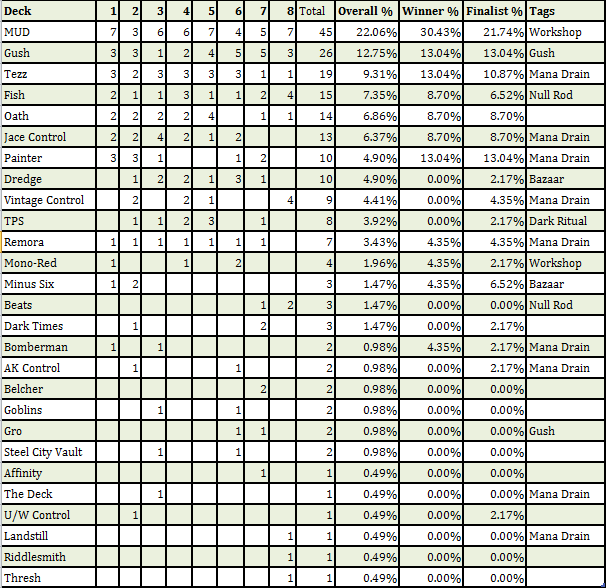
And, to subdivide the larger headings, including MUD, Tezz, Gush, and so on, we get the following subdivision chart, in alphabetical order:
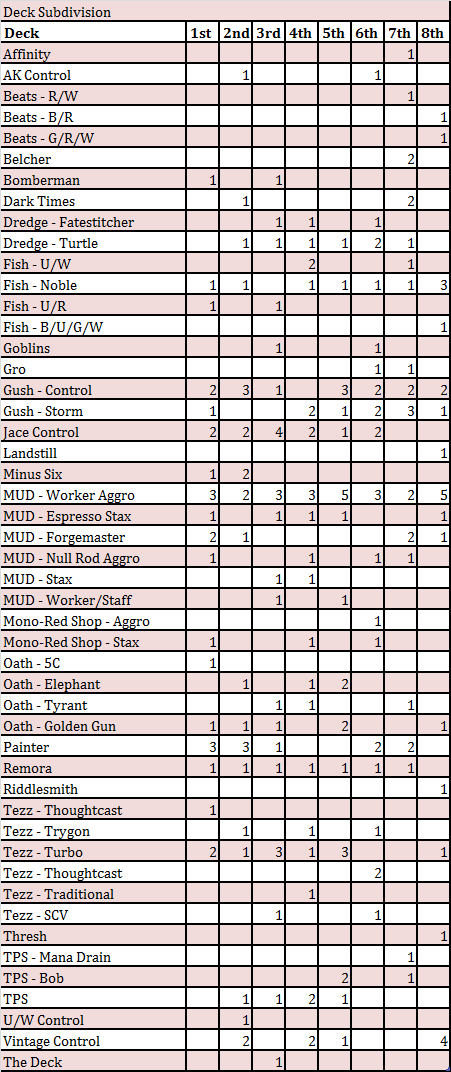
Finally, this last table contains the entire contents of the metagame during Q1, listing each event’s Top 8:
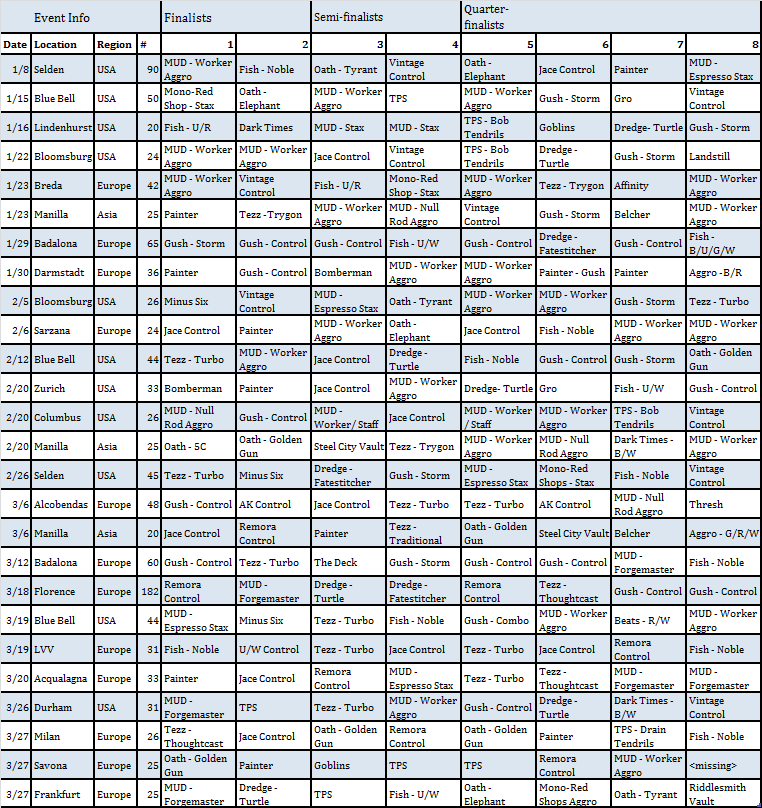
That’s a lot of data to chew on; the archetype breakdowns should help make this a bit clearer, and you can also sort out the results by downloading the
Excel sheet to isolate events by continent or player size.
General Trends in Q1
As you proceed through the various archetype data, here are some trends to consider.
The European metagame diverged rather sharply from the US metagame during Q1. Europe reflected a much stronger presence of Gush during Q4, and that
continued into Q1, developing further to reflect a strong anti-Gush contingent fueled by Painter and Mystic Remora decks. By contrast, the US continued
to be dominated by Workshop decks.
Perhaps most interesting is the return of the Mana Drain decks, foreshadowed by Brian DeMars in December 2010; when added together, Drain decks had a
huge resurgence during Q1, with DeMars’ Control Slaver update, Vintage Control, putting up solid results early in the quarter, and then giving way to
John Jones and his Turbo Tezz deck, and various versions of Jace Control and Remora Control.
Overall, Gush decks grew in popularity and continued to break down into two strategies: Gush Control, which usually contains Mana Drains and often Time
Vault, and Gush Combo, which is more Storm-centric and may include accelerants such as Dark Ritual or Lotus Cobra. The latter version is more popular
in the US.
No matter where you played, Dark Ritual decks struggled badly throughout the quarter, punished by Workshop decks in the US and Remora / Gush in Europe.
Similarly, Dredge struggled throughout the quarter but showed some signs of life in March, and Minus Six had strong results despite limited play,
revealing some life in the Bazaar pillar.
With Tezzeret decks specifically listed as Tezz only, the trend looked like this from Q4 into Q1:
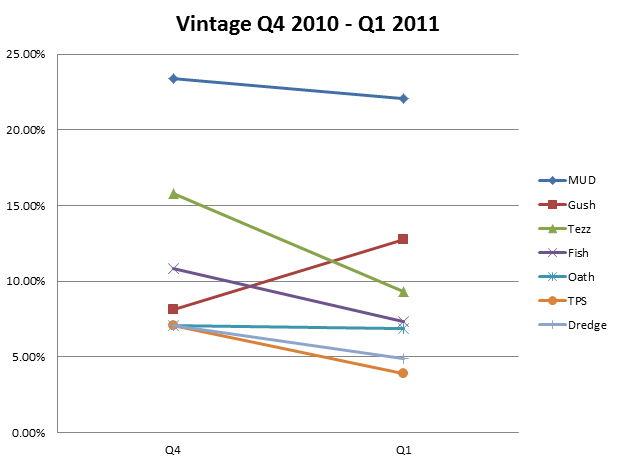
If you take the various Drain decks, inclusive of non-Gush Drain decks playing Mana Drains—Tezz, Jace Control, Vintage Control, and Remora Control—and
merge them, then you get the following, which perhaps creatures a nomenclature issue but more accurately reflects the resurgence of Mana Drain during
the quarter-on-quarter results:
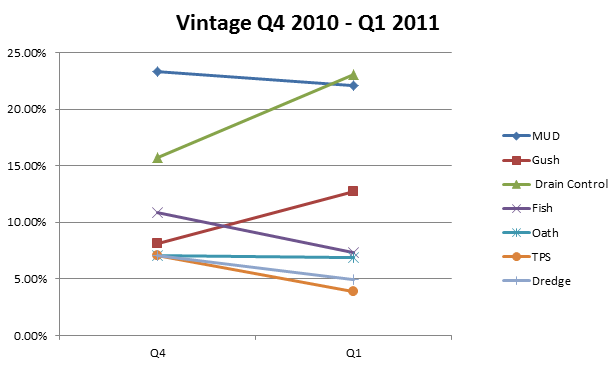
Note that several distinct Drain decks—including Painter, The Deck, and Bomberman—were not included. These decks have differences that go beyond their
choice of draw engine; additionally, most of the decks I included generally play Time Vault as a win condition.
Probably the most striking thing about this latter graph is that it reveals a widening gap between Mana Drain, Workshop, and Gush decks compared to
Fish, Oath, and TPS decks.
Deck Analysis—MUD / Mono-Red Shops
During Q4, MUD was the dominant deck in Vintage. Generally speaking, this trend continued during Q1, as MUD decks won seven of the twenty-six
tournaments in the quarter, with another won by Mono-Red Shops:

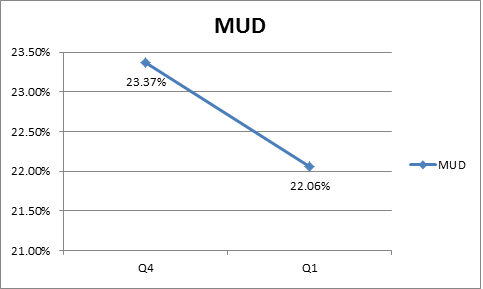
Of the winning MUD decks, three reflect wins by Metalworker Aggro (which had five finals appearances), two by Forgemaster decks (which had three in the
finals), and one each of Espresso Stax and Null Rod Aggro. These results are interesting given an ongoing debate between two of the sharper minds of
Vintage, Stephen Menendian and Nick Detwiler. Stephen has vocally thrown his weight behind Null Rod Aggro during last year’s Vintage Champs season and
again during Q1, while Nick has been a vocal supporter of Espresso Stax, a Smokestack variant that smooths its opening hands using Serum Powder and
which has pushed a small number of players to strong results including a Top 8 at Waterbury 14, Vintage Champs 2010, and wins at Bloomsburg and Blue
Bell.
So, who’s winning the debate, Null Rod or Smokestack? The answer, of course, is Metalworker.
Here we see another quarter where Metalworker decks have far and away dominated the Workshop archetype, and the metagame as a whole. Metalworker decks
took 31 of the 208 spots in the Top 8, with non-Metalworker decks taking only eleven of those spots. That being said, Workshop decks without
Metalworker picked up another potent weapon in Phyrexian Revoker, a card that is not only potent against Metalworker but one which supplements Null
Rod, Wasteland, and other mana disruption in MUD Aggro builds. Expect the tension between Null Rod, Smokestack, and Metalworker versions of MUD to
continue throughout Q2.
Let’s take a look at the four key MUD decks from Q1:
Creatures (20)
- 4 Metalworker
- 1 Karn, Silver Golem
- 1 Triskelion
- 1 Duplicant
- 4 Lodestone Golem
- 3 Steel Hellkite
- 2 Kuldotha Forgemaster
- 1 Myr Battlesphere
- 3 Phyrexian Revoker
Lands (14)
Spells (26)

Forgemaster MUD decks include some number of Kuldotha Forgemaster, a powerful addition that can find finishers like Karn or Steel Hellkite, as well as
emergency Duplicants, Phyrexian Revoker, or various sideboard cards. Some versions play a full set of Forgemasters and include Time Vault and Voltaic
Key, while others use it just to supplement a more traditional Metalworker shell.
Early in the quarter, American Vintage was dominated by Sam Berse’s version of MUD, an aggressive Metalworker build:
Creatures (15)
Lands (18)
Spells (27)

Note that all three of this deck’s tournament wins during Q1 came during January, while both of the Forgemaster builds’ wins came during March.
Creatures (9)
Lands (17)
Spells (34)
- 1 Mana Vault
- 1 Sol Ring
- 1 Mana Crypt
- 4 Sphere of Resistance
- 3 Crucible of Worlds
- 1 Trinisphere
- 4 Smokestack
- 4 Serum Powder
- 4 Tangle Wire
- 1 Mox Emerald
- 1 Mox Jet
- 1 Mox Pearl
- 1 Mox Ruby
- 1 Mox Sapphire
- 4 Chalice of the Void
- 2 Thorn of Amethyst
Sideboard

Will is a long-time competitor in the Blue Bell Vintage tournaments and has worked closely with Nick Detwiler in recent months; despite a relatively
small number of players using the deck in the Northeast, Espresso Stax has performed relatively consistently since its development in mid-2010.
Creatures (12)
Lands (18)
Spells (30)

Finally, this is the hyper-aggressive non-Metalworker MUD deck that Stephen Menendian has championed. It’s really adept at locking out opponents using
Revoker and Null Rod and finishes games quickly with Precursor Golem.
Deck Analysis—Mana Drain Control
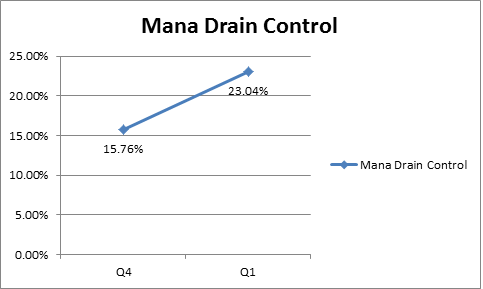
In December 2010, Brian DeMars proclaimed, “Mana Drain is back!” Although he was specifically referencing his new deck, the imaginatively named
“Vintage Control,” the sentiment has proven to be highly accurate. Early in the quarter, the deck DeMars created, which is an updated version of
Control Slaver adapted for the loss of Thirst for Knowledge and playing Time Vault instead of or alongside Mindslaver, showed itself to be an able
competitor for Workshop decks. Note that many players and Tournament Organizers still refer to this style of deck as Control Slaver.
As the quarter progressed, John Jones broke through with his Turbo Tezz creation. Those who watch Vintage closely may have seen versions of this deck
in Top 8s at Bloomsburg previously, as John spent some time honing it into a weapon that powered him to back-to-back Blue Bell/NYSE wins. This deck has
spread globally and helped account for the surge in Mana Drain decks.
In Europe in particular, Mystic Remora decks have become popular, countering Gush with the draw power of Mystic Remora, often supported by Mindbreak
Trap. These Remora builds, alongside Painter’s Servant decks, are a strong foil for Gush strategies.
Creatures (3)
Planeswalkers (2)
Lands (17)
Spells (38)
- 1 Sensei's Divining Top
- 1 Brainstorm
- 3 Mana Drain
- 1 Vampiric Tutor
- 1 Mystical Tutor
- 1 Yawgmoth's Will
- 4 Force of Will
- 1 Sol Ring
- 1 Demonic Tutor
- 1 Time Walk
- 1 Ancestral Recall
- 1 Mana Crypt
- 1 Time Vault
- 1 Gifts Ungiven
- 1 Merchant Scroll
- 1 Thirst for Knowledge
- 1 Mindslaver
- 1 Tinker
- 1 Voltaic Key
- 1 Black Lotus
- 1 Mox Emerald
- 1 Mox Jet
- 1 Mox Pearl
- 1 Mox Ruby
- 1 Mox Sapphire
- 1 Repeal
- 2 Ancient Grudge
- 1 Nature's Claim
- 3 Preordain
- 1 Nihil Spellbomb

Here, you can see the hallmarks of this strategy as developed by DeMars, including City of Brass, Goblin Welder, Preordain, Myr Battlesphere, and
maindeck Nihil Spellbomb.
Creatures (1)
Planeswalkers (5)
Lands (11)
Spells (43)
- 3 Sensei's Divining Top
- 1 Brainstorm
- 2 Mana Drain
- 1 Vampiric Tutor
- 1 Mystical Tutor
- 2 Grim Monolith
- 1 Yawgmoth's Will
- 4 Force of Will
- 1 Mana Vault
- 1 Sol Ring
- 1 Demonic Tutor
- 1 Time Walk
- 1 Ancestral Recall
- 1 Mana Crypt
- 1 Timetwister
- 1 Time Vault
- 1 Merchant Scroll
- 1 Echoing Truth
- 1 Tinker
- 1 Rebuild
- 2 Voltaic Key
- 1 Black Lotus
- 1 Mox Emerald
- 1 Mox Jet
- 1 Mox Pearl
- 1 Mox Ruby
- 1 Mox Sapphire
- 1 Ponder
- 3 Spell Pierce
- 2 Preordain
- 2 Mox Opal

Before it was unbanned in Legacy, Grim Monolith was un-Restricted in Vintage. The Turbo Tezz strategy that John developed makes use of acceleration
from Mox Opal and Grim Monolith to power out early Tezzeret the Seeker or Jace, the Mind Sculptor. Some versions of this deck play as many as four
Tezzeret the Seekers, and additional Grim Monoliths are not uncommon. This deck can be unbelievably fast; in one match against it at Blue Bell, I got
two turns during the entire match. You may notice the use of Red Elemental Blast to combat Gush; because the deck plays a one-card win in Tezzeret, it
can make strong use of Hurkyl’s Recall against Workshops, as it only needs one turn to reset the board and stick Tezzeret.
Creatures (6)
Planeswalkers (1)
Lands (16)
Spells (38)
- 1 Sensei's Divining Top
- 1 Tendrils of Agony
- 1 Brainstorm
- 3 Mana Drain
- 2 Lightning Bolt
- 1 Vampiric Tutor
- 1 Mystical Tutor
- 1 Yawgmoth's Will
- 4 Force of Will
- 1 Sol Ring
- 1 Demonic Tutor
- 2 Hurkyl's Recall
- 1 Time Walk
- 1 Ancestral Recall
- 1 Mana Crypt
- 1 Merchant Scroll
- 1 Thirst for Knowledge
- 3 Mystic Remora
- 1 Tinker
- 1 Black Lotus
- 1 Mox Emerald
- 1 Mox Jet
- 1 Mox Pearl
- 1 Mox Ruby
- 1 Mox Sapphire
- 2 Repeal
- 2 Mindbreak Trap

While this version does not include the Key/Vault combo, I think many people would suggest including it, and many Remora decks often include Time
Vault. That said, this deck won the largest tournament that took place during the first quarter of 2011. Mystic Remora, Mindbreak Trap, and Red
Elemental Blast in the sideboard make this deck potent against Gush, while sideboard cards like Ingot Chewer and Rack and Ruin, alongside Lightning
Bolts for Golems and two Hurkyl’s Recalls in the maindeck, ensure plenty of play against Workshops.
Deck Analysis—Gush
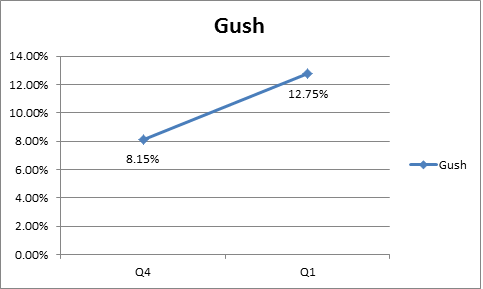
During Q4, Gush was overrepresented among winners and finalists; during Q1, this was no longer as evident. Most notable is the fact that Gush failed to
win a single tournament in the United States and had only one finals appearance; compare this to Europe, where Gush won three tournaments, with two
finals appearances on top.
Generally speaking, Gush decks broke down into two strategies, Control and Storm. The Control decks have tended to play one Tendrils supported by
Tinker, usually including Blightsteel Colossus and often Time Vault. The Storm builds tend to play accelerants like Dark Ritual or Lotus Cobra, bounce
effects like Repeal and Hurkyl’s Recall, and multiple storm cards (sometimes two Tendrils, sometimes Tendrils and Empty the Warrens, and some European
builds have used two Brain Freeze), often supported by a Tinker target, but without Time Vault.
Creatures (1)
Planeswalkers (2)
Lands (14)
Spells (43)
- 1 Tendrils of Agony
- 1 Brainstorm
- 1 Fastbond
- 3 Mana Drain
- 1 Vampiric Tutor
- 1 Mystical Tutor
- 1 Yawgmoth's Will
- 4 Force of Will
- 1 Sol Ring
- 1 Demonic Tutor
- 1 Hurkyl's Recall
- 1 Time Walk
- 1 Ancestral Recall
- 1 Mana Crypt
- 4 Gush
- 1 Timetwister
- 1 Gifts Ungiven
- 1 Merchant Scroll
- 1 Tinker
- 1 Black Lotus
- 1 Mox Emerald
- 1 Mox Jet
- 1 Mox Pearl
- 1 Mox Ruby
- 1 Mox Sapphire
- 3 Repeal
- 2 Thoughtseize
- 1 Mindbreak Trap
- 4 Preordain

Creatures (1)
Lands (14)
Spells (45)
- 2 Sensei's Divining Top
- 1 Tendrils of Agony
- 1 Brainstorm
- 1 Fastbond
- 3 Mana Drain
- 1 Vampiric Tutor
- 1 Mystical Tutor
- 1 Yawgmoth's Will
- 4 Force of Will
- 1 Sol Ring
- 1 Demonic Tutor
- 1 Time Walk
- 1 Ancestral Recall
- 1 Mana Crypt
- 4 Gush
- 1 Time Vault
- 1 Gifts Ungiven
- 1 Merchant Scroll
- 1 Tinker
- 1 Voltaic Key
- 1 Black Lotus
- 1 Mox Emerald
- 1 Mox Jet
- 1 Mox Pearl
- 1 Mox Ruby
- 1 Mox Sapphire
- 1 Ancient Grudge
- 3 Thoughtseize
- 4 Preordain
- 1 Mox Opal
- 1 Nihil Spellbomb

The first deck is an example of European Gush Control, or Spanish Gush, which does not play Time Vault. Particularly interesting is the use of an Oath
transform approach in the sideboard, which is one approach a Gush deck can use to combo Mishra’s Workshop decks. The second version has been played
more in American tournaments by players like Jerry Yang and Brad Granberry. Mox Opal and Sensei’s Divining Top make these decks consistent and very
fast compared to traditional Tezz or Jace Control.
Planeswalkers (1)
Lands (15)
Spells (44)
- 1 Brainstorm
- 1 Fastbond
- 3 Mana Drain
- 1 Vampiric Tutor
- 1 Mystical Tutor
- 1 Yawgmoth's Will
- 4 Force of Will
- 1 Mana Vault
- 1 Sol Ring
- 1 Regrowth
- 1 Demonic Tutor
- 1 Hurkyl's Recall
- 1 Time Walk
- 1 Ancestral Recall
- 1 Mana Crypt
- 4 Gush
- 1 Timetwister
- 1 Gifts Ungiven
- 2 Brain Freeze
- 1 Mind's Desire
- 1 Merchant Scroll
- 1 Misdirection
- 1 Rebuild
- 1 Black Lotus
- 1 Lotus Petal
- 1 Mox Emerald
- 1 Mox Jet
- 1 Mox Ruby
- 1 Mox Sapphire
- 1 Ponder
- 1 Mindbreak Trap
- 3 Spell Pierce
- 1 Nihil Spellbomb
Sideboard

Creatures (4)
Planeswalkers (1)
Lands (14)
Spells (41)
- 1 Tendrils of Agony
- 1 Brainstorm
- 1 Fastbond
- 1 Vampiric Tutor
- 1 Mystical Tutor
- 1 Yawgmoth's Will
- 4 Force of Will
- 1 Necropotence
- 1 Sol Ring
- 1 Demonic Tutor
- 1 Hurkyl's Recall
- 1 Time Walk
- 1 Ancestral Recall
- 1 Imperial Seal
- 1 Mana Crypt
- 4 Gush
- 1 Time Vault
- 1 Gifts Ungiven
- 1 Merchant Scroll
- 1 Tinker
- 1 Voltaic Key
- 1 Black Lotus
- 1 Lotus Petal
- 1 Mox Emerald
- 1 Mox Jet
- 1 Mox Pearl
- 1 Mox Ruby
- 1 Mox Sapphire
- 1 Ponder
- 2 Thoughtseize
- 4 Preordain
Sideboard

Above, you can see an example of the differences between the Storm versions of Gush; these are just examples of this strategy, which has a relatively
wide range of approaches. Andy Probasco recently discussed another version, which is essentially an update of the old Tropical Storm decks, and
includes many of the cards you would see in TPS, supported by the Gush/Bond engine.
Deck Analysis—Dredge
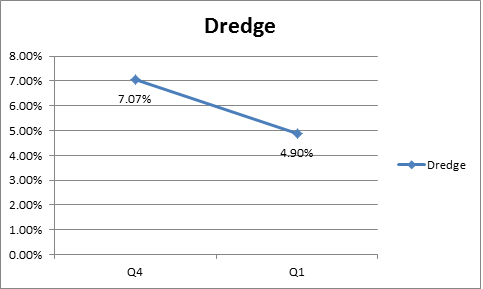
As noted, Dredge did not have a strong quarter, although it did show signs of life by putting two players into the top four of the largest tournament
in the quarter.
Creatures (22)
- 2 Ichorid
- 1 Flame-Kin Zealot
- 4 Golgari Grave-Troll
- 2 Golgari Thug
- 4 Stinkweed Imp
- 4 Narcomoeba
- 4 Bloodghast
- 1 Terastodon
Lands (12)
Spells (26)
- 3 Unmask
- 4 Cabal Therapy
- 4 Serum Powder
- 4 Chalice of the Void
- 1 Darkblast
- 4 Leyline of the Void
- 2 Dread Return
- 4 Bridge from Below
Sideboard

Creatures (28)
- 3 Ichorid
- 1 Flame-Kin Zealot
- 4 Golgari Grave-Troll
- 3 Golgari Thug
- 4 Stinkweed Imp
- 4 Narcomoeba
- 3 Fatestitcher
- 4 Bloodghast
- 1 Iona, Shield of Emeria
- 1 Terastodon
Lands (13)
Spells (20)
Sideboard

One version used Fatestitcher, which is a potent accelerant against non-Workshop decks, while the other is a more traditional Turtle-style Dredge deck.
Note that both used Unmask, a card that hasn’t been all that popular in the US since the emergence of Workshop decks. With many people skimping on
Dredge hate, Dredge could see a resurgence in the next quarter. I’d definitely note that if Workshops are seeing less play in your metagame, and Dredge
hate has softened, Fatestitcher Dredge can cut through an unprepared field like a buzz saw.
While Dredge struggled, another Bazaar-fueled deck, Minus Six, did very well in the hands of players like Nick Coss and Jake Gans:
Creatures (8)
Lands (18)
Spells (34)
- 1 Sensei's Divining Top
- 1 Brainstorm
- 1 Vampiric Tutor
- 1 Mystical Tutor
- 4 Duress
- 4 Force of Will
- 2 Dance of the Dead
- 2 Animate Dead
- 1 Sol Ring
- 1 Demonic Tutor
- 1 Time Walk
- 1 Ancestral Recall
- 1 Mana Crypt
- 1 Necromancy
- 2 Intuition
- 2 Read the Runes
- 1 Thirst for Knowledge
- 1 Echoing Truth
- 1 Black Lotus
- 1 Mox Emerald
- 1 Mox Jet
- 1 Mox Pearl
- 1 Mox Ruby
- 1 Mox Sapphire

With regard to this deck, I would caution you only in that the deck has done well in the hands of a few accomplished Vintage players specifically; this
deck is not particularly easy to pilot. It also doesn’t do all that well in a metagame with a lot of Dredge, as it has no Dredge hate due to its
transformation strategy.
Deck Analysis—Oath of Druids

While declining slightly in popularity, Oath had a strong month in terms of win percentage once in the elimination rounds. That said, Oath still tended
to have its strongest showing in smaller events and would have had a much weaker month if events under 33 players were not included.
Creatures (2)
Planeswalkers (2)
Lands (16)
Spells (40)
- 1 Brainstorm
- 1 Vampiric Tutor
- 1 Mystical Tutor
- 4 Oath of Druids
- 1 Yawgmoth's Will
- 4 Force of Will
- 1 Sol Ring
- 1 Regrowth
- 1 Demonic Tutor
- 1 Time Walk
- 1 Ancestral Recall
- 1 Mana Crypt
- 1 Time Vault
- 1 Gifts Ungiven
- 1 Merchant Scroll
- 1 Lim-Dul's Vault
- 2 Dragon Breath
- 1 Tinker
- 1 Voltaic Key
- 1 Black Lotus
- 1 Mox Emerald
- 1 Mox Jet
- 1 Mox Pearl
- 1 Mox Ruby
- 1 Mox Sapphire
- 2 Thoughtseize
- 3 Spell Pierce
- 3 Preordain

Above is an example of a “Golden Gun” style Oath with the potential to win on a single Oath activation; this version of Oath saw some traction during
Q1, with players putting their unique stamp on the shell of the deck that was developed with the printing of Blightsteel Colossus.
Creatures (3)
Planeswalkers (3)
Lands (17)
Spells (37)
- 1 Brainstorm
- 3 Mana Drain
- 3 Lightning Bolt
- 1 Vampiric Tutor
- 1 Mystical Tutor
- 4 Oath of Druids
- 1 Yawgmoth's Will
- 4 Force of Will
- 1 Sol Ring
- 1 Demonic Tutor
- 1 Time Walk
- 1 Ancestral Recall
- 1 Mana Crypt
- 1 Time Vault
- 1 Gifts Ungiven
- 1 Merchant Scroll
- 1 Tinker
- 1 Voltaic Key
- 1 Black Lotus
- 1 Mox Emerald
- 1 Mox Jet
- 1 Mox Pearl
- 1 Mox Ruby
- 1 Mox Sapphire
- 2 Spell Pierce
- 1 Nature's Claim

The largest tournament in Q1 in the US was also the first and included a Tyrant Oath in the Top 8, as well as the Elephant Oath listed above. Although
Elephant Oath hasn’t been as popular lately, I think Mental Misstep may help this deck become viable again, something I’ll discuss in my next article.
Tyrant Oath has quickly dropped off in favor of other Gush decks.
Deck Analysis—Fish
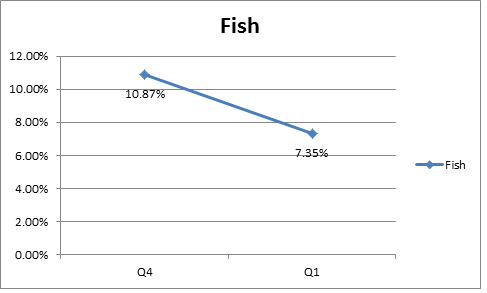
Fish, like Dredge and TPS, saw a drop-off from Q4 to Q1. The majority of Fish decks, especially in the US, are still Noble Fish, while Europe displayed
more variety, including U/R and U/W Fish. The challenge for Fish decks is finding a strategy that can keep up with Gush, Drains, and Workshops, all of
which require different answers.
Creatures (16)
Lands (17)
Spells (27)

This list is notable in that it uses a full set of four Cold-Eyed Selkies, with four Dazes and three Spell Pierces providing plenty of countermagic.
Deck Analysis – TPS
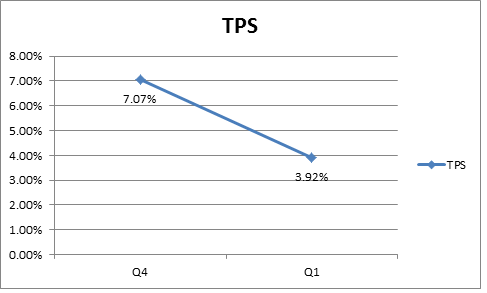
Players opting for Storm strategies have tended to use Gush rather than more traditional TPS strategies during Q1. Gush decks offer similar speed and
can make good use of the storm mechanic without being as reliant on Dark Ritual or Cabal Ritual, both of which are liabilities against Workshops. This
quarter didn’t reveal much new in the way of TPS strategies, as most of the development in Storm decks appeared to be focused on Gush Storm.
Deck Analysis—Other Notable Decks
While some traditional strategies like Dark Times continue to see play, the most notable change during Q1 was the emergence of Painter’s Servant decks
as a foil for Gush strategies:
Creatures (9)
Planeswalkers (1)
Lands (16)
Spells (34)
- 1 Sensei's Divining Top
- 1 Brainstorm
- 3 Mana Drain
- 1 Vampiric Tutor
- 1 Mystical Tutor
- 1 Yawgmoth's Will
- 4 Force of Will
- 2 Grindstone
- 1 Sol Ring
- 1 Demonic Tutor
- 1 Hurkyl's Recall
- 1 Time Walk
- 1 Ancestral Recall
- 2 Red Elemental Blast
- 1 Mana Crypt
- 1 Merchant Scroll
- 1 Thirst for Knowledge
- 2 Pyroblast
- 1 Misdirection
- 1 Tinker
- 1 Black Lotus
- 1 Mox Emerald
- 1 Mox Jet
- 1 Mox Pearl
- 1 Mox Ruby
- 1 Mox Sapphire
Sideboard

Creatures (10)
Lands (16)
Spells (34)
- 1 Sensei's Divining Top
- 1 Brainstorm
- 3 Mana Drain
- 1 Vampiric Tutor
- 1 Mystical Tutor
- 1 Yawgmoth's Will
- 4 Force of Will
- 2 Grindstone
- 1 Sol Ring
- 1 Demonic Tutor
- 1 Hurkyl's Recall
- 1 Time Walk
- 1 Ancestral Recall
- 2 Red Elemental Blast
- 1 Mana Crypt
- 1 Merchant Scroll
- 2 Pyroblast
- 1 Tinker
- 1 Black Lotus
- 1 Mox Emerald
- 1 Mox Jet
- 1 Mox Pearl
- 1 Mox Ruby
- 1 Mox Sapphire
- 1 Ponder
- 1 Preordain
Sideboard

Patrick named his deck “Jace Sucks,” and his list certainly shows a hatred for the sculpting of minds. Painter decks are quite powerful against Gush,
but also are pretty reasonable against Workshops, as both parts of the Painter combo dodge Lodestone Golem and Painter also dodges Thorn of Amethyst,
and the basic Mountain provides a lot of anti-Shop options in the sideboard.
Conclusions
While the differences between some Vintage decks may be subtle, I counted 49 different archetypes and sub-archetypes during the first quarter, an
impressive amount of diversity. Workshops, Mana Drains, and Gush appear to be pulling away from the pack; what will the second quarter bring, as the
road to Vintage Champs 2011 begins?
Matt Elias
[email protected]
Voltron00x on SCG,TMD, and The Source
